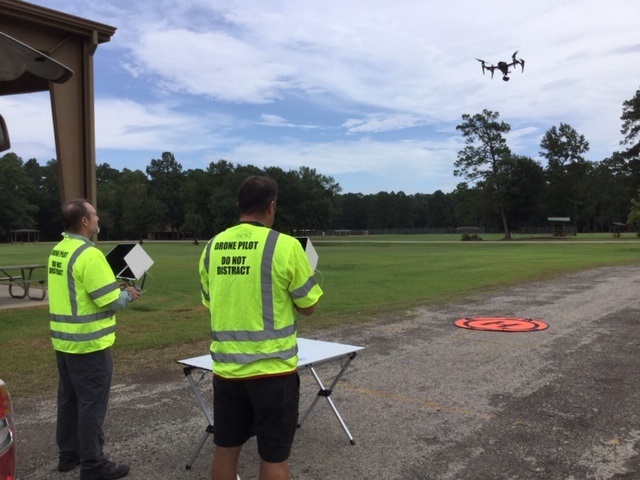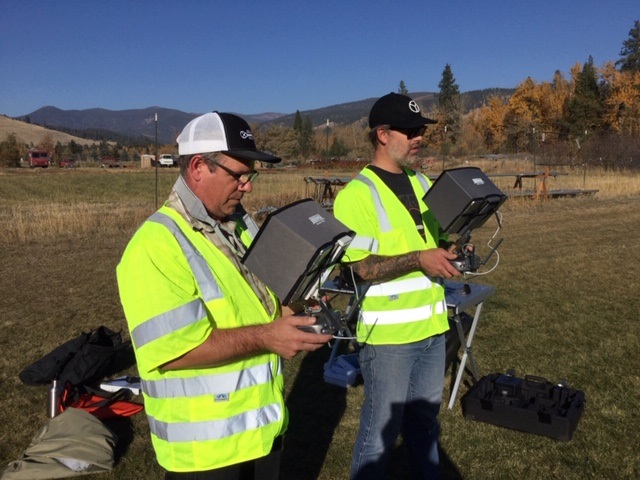Sinclair Broadcast Group last week announced its 10,000th drone flight—a Jan. 30 newsgathering mission for WPMI-TV, the station group’s NBC affiliate in Mobile, Ala.
The flight, commanded by Robby Hughes from WEAR-TV, Sinclair’s ABC affiliate in Pensacola, Fla., with visual observer Jan Czernik in Mobile, marks a milestone not just for Sinclair but the TV industry at large, which only a few years ago received a nod from the federal government to begin using drones for newsgathering.

Sinclair began using drones at its TV stations in August 2016, after its initial drone pilots received their Part 107 FAA certification. Currently, the station group has 45 drone-operating TV stations, 108 FAA certified drone pilots and 64 trained visual observers.
In this interview, Sinclair chief pilot Jeff Rose discusses the station group’s use of drones, the training and best practices it's put in place to promote safe drone operation, the opportunity for competitive stations to cooperate in their drone operations, the most important developments in drone design since launching operations two and half years ago and how an FAA waiver allowing night flights are capturing captivating footage for Sinclair stations.
(An edited transcript.)
TVTechnology:You have 108 FAA certified drone pilots. How does Sinclair select the people who become pilots?
Jeff Rose: We currently have 45 TV stations that are drone-capable. We leave it up to those news departments or their news managers to select who on their staff they would like to be trained as a drone pilot.
The professional video industry's #1 source for news, trends and product and tech information. Sign up below.
We urge them to choose employees—and they are often news photographers—that they can count on after they have been trained to make really good decisions for the company.
TVT:Does every Sinclair drone crew consist of a pilot and observer?
JR: Yes. We require two-person operation—one pilot and one visual observer. In many cases, a second pilot stands in as the visual observer.
TVT:Sinclair puts its prospective pilots through a three-day training program to become a drone pilot. Who puts that on?
JR: We take all of our drone pilots to Virginia Tech, which is an FAA designated test site. There is a half dozen of those across the country.
We chose Virginia Tech and have a great relationship with them. They put on a great three-day program for journalists operating drones.
TVT:Is there any special training that the visual observers receive?
JR: Yes, our visual observers do a three-part training, which consists of two days of a webinar. We created an in-house training session in which our instructors speak to trainees wherever they are in their given markets.
After they go through the two-day class for visual observer training, the third part is an exercise in the field with certified pilots going through actual flights and getting checked out.
TVT:If you are one of the visual observers does that put you in line to become a drone pilot at Sinclair?
JR: Many times, yes. It’s not a requirement, but lots of times the visual observers become so familiar that they want to become more involved and become a pilot. It is a natural progression.

TVT:Sinclair has developed a set of best practices for drone use. Can you discuss them and their development?
JR: We started with guidelines from professionals in the aviation industry. Then we enhance that by learning as we go so that when we find things that work better for our program, we turn them back into a checklist—whether that’s a pre-flight briefing or pre-flight inspection, those types of things.
This way over time our safety protocols evolve and get better and better.
TVT:You mentioned in the press release announcing the 10,000th drone flight by Sinclair that the value of best practices extends beyond safety by promoting teamwork. How so?
JR: All of our pilots have been through the same training, use the same equipment and operate under the same procedures.
One example occurred when we had a hurricane in the Carolinas and the crews on the field were so busy with live, round-the-clock coverage that they didn’t have time to fly.
We recruited two pilots from other stations that were impacted, and those two pilots met at the scene of the hurricane, said, “Hello, nice to meet you,” knew exactly what to do with the same equipment and went right to work.
I got a communication from one of those pilots at the end of the day. The pilot said, “You know Jeff, I am really pleased with how well this worked. Even though I just met the other pilot it seems as though we had been working together for months.” So, we thought that was a real success.
TVT:Sinclair started using drones in August 2016. Are there any flights or footage that stand out in your mind as the high mark of drone use by Sinclair?
JR: We have so many. Hurricane coverage and other natural disasters are just naturals for drone coverage because you need to see a large area and what the devastation is.
And there’s really not a lot of people to fly over if it is all flooded or if a town has been blown away—that type of thing.
We also have a night waiver that gives us a beautiful view during nighttime that’s somewhat unique in such a large group as we have.
That waiver allows us to capture beautiful footage that the viewers are crazy for—fireworks and Christmas lights displays and sunset skylines over the cities that are not normally seen from that perspective.
TVT:You have a waiver to fly at night. I didn’t realize the FAA was making those available.
JR: Yes, we do. The waiver allows for all kinds of new possibilities that viewers aren’t accustomed to and get really excited about.
TVT:How long have you had the waiver?
JR: I think since last May.
TVT:Does it cover all the drone-operating Sinclair stations?
JR: It does, with additional training. Everyone has to do one more step of training. But they all have the ability to qualify for night operations.
Some of the other [stand out uses of drones] are news stories that you can’t otherwise get access to.
For instance, in Chattanooga, Tenn., we had a cave in when a trench collapsed at a breaking news scene.
When all of the other TV stations were kept two blocks away by a barricade, the fire department and police department, we were able to go to another location that was clear of people, launch the drone, take it in without flying over people, and shoot the entire scene and broadcast it live. It was video no one else could get. So, in some cases it gives you a vantage point that no one else has.
TVT:I think before the FAA issued its rules for drone use, there were a lot of opinions about how these aerial platforms could enhance newsgathering. One in particular was the idea that a station could pull up to a crime scene, launch a drone and get footage of an otherwise inaccessible spot cordoned off by police tape. But when the rules came out, there was no flying over people. So, have restrictions like that changed attitudes about the place of drones in newsgathering? In other words, what is realistic and not?
JR: I think the more we use drones, the more the entire staff gets excited and involved.
Starting in the morning meeting, asking, “How can we use the drone today?”
As far as breaking news, our program is not quick setup. Our safety protocols require 20 minutes to a half hour before we can actually put the drone up.
It’s not run out there, park and fly. There are a lot of steps to go through.
TVT:It seems like the requirement to avoid flying over people on the ground ultimately controls whether or not you can get a shot.
JR: The most important rule that we have to abide by is not flying over people.
That guides a lot of what we do. We are very successful in finding places to fly that are next to an event.
A lot of times, we will ask permission. If there is something going on where there are a lot of people, like in a city, we will just ask someone if we can use their yard.
Maybe their yard is fenced in. If they give us permission we say, “Hey, don’t let your children or dog out in the backyard for the next hour. We would really appreciate it.”
We then use the yard as a launch area and stay over that as a safe place to fly.

TVT:In any of the 45 markets where Sinclair operates drones are there other stations using drones for newsgathering? Do you find that you and your competitor are flying in the same area to get footage for a story?
JR: We do. We seem to be ahead of our competitors, but over time other stations are starting to fly. Many of them are learning a lot of things we already know in order to be FAA-compliant.
But first and foremost, if we see a competitor flying, we go and talk to them before we ever set up. We know we are in danger of running into each other and we don’t want that to happen.
Safety comes before the shot, and we’ll go work out an agreement with whomever is flying.
TVT:I am reminded of competitive TV stations that all belong to the SBE and coordinate microwave frequency usage for ENG, for instance. Can you foresee a day when more and more stations will have drones and that there will need to be some analogous type of organization to coordinate flights and maintain safety?
JR: I absolutely do see that. As a matter of fact, we are already there. I have been in communications with the FAA, and they are interested in how we can coordinate with each other in order to pool video.
In certain circumstances—like maybe a large news scene—it’s not a good idea to have multiple drones airborne.
I’ll give you a good example: the Camp Fire wildfire in California. When the FAA finally put out authorizations for news operations to fly in the same place and at the same time, there were a dozen drones in the sky at the same time. That’s probably not the best idea.
If we can coordinate pooling video and having one crew under the guidelines of the FAA on site, then we could probably get much better access, share the video and be safer overall. Now, that’s limited use for certain large events.
Beyond that, I think across the country where we are operating, it’s going to be coordinating with competitors on the scene.
TVT:What would you guess is the mix of drone use for news vs. promotions at Sinclair?
JR: Drones are very much primarily used in the news department, but promotions will shoot some stuff that they use—whether it is a microwave truck driving down the road to reveal the skyline for a great promo or reporter standups.
But the majority is what we do for the news department in newscasts in addition to other outlets, like our SOAR [Sailing Over America] program.
TVT:What are the most important improvements you’ve seen in drones since you started doing this in August 2016?
JR: It’s pretty simple. We started out with a white drone. When it goes up against the sky, it becomes almost invisible.
The manufacturers realized that, and their second version of our DJI Inspire aircraft is dark gray. That sounds so simple, but it is really important. When you fly a drone 2,000 feet away, you have to be able to see it against the sky.
If you go past that, the new drones that are coming out today have sensors all the way around them, above and below, that will keep them from running into anything.
If you flew it straight at a building, 5 feet away from the building it would come to a stop. Those are fantastic benefits for what we do.
TVT:How often does a drone have to be overhauled, or do you just simply replace it?
JR: They are very low maintenance. I believe we have replaced the motors on an Inspire at 300 hours. They are brushless gimbal motors. There’s really nothing to wear out.
We replace rotor blades and batteries. Those are really our lifeblood. So, we baby batteries and we change rotor blades on a regular basis. We keep track of that in the maintenance record.
TVT:What are you shooting with the drones?
JR: We shoot 1080i, although we use bonded cellular. By time it gets back to the station it’s 720p.
But the drones have the capability of 4K. If the promotions department wants 4K, we just switch to 4K and when we are done, we just hand them a video card and they go edit.
TVT:Tell me about the Inspire drones you fly.
JR: We currently fly the DJI Inspire 2, which is ideally suited for two-person operations.
It has landing gear that retracts and gives you a 360-degree view with the camera independent of the aircraft.
TVT:Is there anything else you’d like to add about drones?
JR: Over time we have learned that drones can be used safely, even in 10,000 flights.
I think that if you have well-defined safety procedures and you have thorough pilot training and strong corporate support, those things come together to represent the safety culture of our program.
We have learned over time you require all of those things to be successful.
Phil Kurz is a contributing editor to TV Tech. He has written about TV and video technology for more than 30 years and served as editor of three leading industry magazines. He earned a Bachelor of Journalism and a Master’s Degree in Journalism from the University of Missouri-Columbia School of Journalism.

